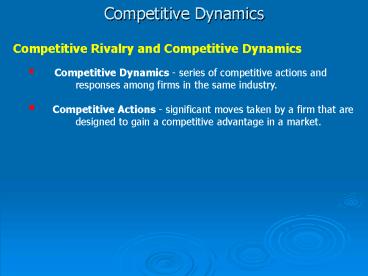Competitive Dynamics - PowerPoint PPT Presentation
1 / 10
Title:
Competitive Dynamics
Description:
Managers unwilling to bear the risk associated with innovation. ... technology to establish industry standard (Sun Microsystems). Competitive Dynamics ... – PowerPoint PPT presentation
Number of Views:453
Avg rating:3.0/5.0
Title: Competitive Dynamics
1
Competitive Dynamics
Competitive Rivalry and Competitive Dynamics
- Competitive Dynamics - series of competitive
actions and - responses among firms in the same
industry. - Competitive Actions - significant moves taken
by a firm that are - designed to gain a competitive advantage
in a market.
2
Competitive Dynamics
- Likelihood of Response - what determines if a
competitor responds?
Market dependence ? High
concentration in or dependence on an industry
increases likelihood of a response. ?
Single and dominant businesses are more likely
to respond. Competitor resources ?
Small firms are more likely to respond to
tactical as opposed to strategic actions
(because tactical requires fewer
resources). ? Lack of resources may provide
an incentive to seek partners to mount
an effective response. Actors reputation ?
Actions by market leaders are more likely to lead
to responses by competitors than
actions by small firms in the
industry. ? Actions initiated by firms with
a previous history of success will be
more likely to result in quick reactions and
imitation.
3
Competitive Dynamics
- Timing of Actions and Responses
First movers - firms that takes initial
competitive action. ? Earn above normal
profits until competitors respond
effectively. ? Gain customer loyalty and
develop barriers to entry. ? Gain a
sustainable competitive advantage. Second movers
- respond to the first movers competitive
action. ? Evaluate customers reactions to
first mover actions ? Less risky, evaluate
first movers successes and failures. ?
Avoid market development costs (paid by first
mover). Late movers - firms that respond but
only after considerable time. ?
Performance usually suffers because of this.
4
Competitive Dynamics
- Type of Action (strategic vs. Tactical and
offensive vs. defensive)
Strategic vs. Tactical ? Strategic -
significant commitment of specific and
distinctive resources.
- ATTs World Serve (global telecommunications).
- MCI - BT strategic alliance
(pre Worldcom). - Schumpeterian
innovations and pre-emptive strategies. ?
Tactical - fine tuning of business level strategy
using general resources. -
Price increases or decreases. -
KFCs expansion of menu items to counter Boston
Chicken coupled with extensive
advertising in those regions. -
Frontal assaults, guerilla offensives,
multi-point competition etc.
5
- Type of Action (strategic vs. Tactical and
offensive vs. defensive)
Offensive vs. Defensive ? Offensive -
significant commitment of specific and
distinctive resources. - Frontal
assault Outcome determined
by who has greater resources
Match rivals product (imitate it) then lower
price (clones vs. IBM).
Never try to imitate too closely (especially
strategy). Cost related
strategies are usually best for frontal assaults.
- Attack on lines of weakness
Geographic regions (Coke,
Walmart). Neglected markets
(Safeway vs Foodlion).
Neglected quality, service, gaps in product line
(Dell vs Gateway). Attacks
on rivals weaknesses have a higher success rate
than frontal assaults.
- Guerilla offensives.
Good for small firms who lack resources (Book
buyers). Selective attacks
(timing and stealth are crucial).
6
Competitive Dynamics
- Type of Action (strategic vs. Tactical and
offensive vs. defensive)
? Offensive - Multi-front
competition Requires large
amount of resources (usually 3x that of rival).
Requires good coordination and
a quick reaction time.
Essentially buying market share with expenditures
of resources. - Bypass offensives
Radical or Schumpeterian
innovations. Disrupts
industry as a whole.
Innovator usually
becomes the dominant firm or market
leader. In
essence, you develop the next generation of
products. - Pre-emptive
strategies Expand
production capacity (create over-capacity).
Bundling of resources.
Tie up raw materials from rivals.
Use of contracts (long
term).
7
Competitive Dynamics
- Type of Action (strategic vs. Tactical and
offensive vs. defensive)
? Defensive - Lowers risk
of being attacked. - Usually
doesnt enhance competitive advantage.
- Good strategy for turbulent times (industry
shake-ups, economic downturns).
- Available options
Broaden product line, increase services on
products, purchase excess supplies, lower
prices on products that rival can
duplicate.
Exclusive agreements (similar to bundling) with
buyers and suppliers.
Avoid suppliers that serve
competitors Retrenchment
strategies. Harvest
strategies - Necessity of credible
deterrents. - Goal Lower
inducements for rivals to launch offensives or
for new entry.
8
Competitive Dynamics
- Moderators of Competitive Actions
Firm size ? The larger the firm, the
greater the firms market power. ? Larger
firms tend to adopt bureaucratic controls. ?
These controls stifle competitiveness and the
ability to innovate. ? Size and lack of
innovation make it difficult to be first movers
of respond quickly to competitive
moves.
Speed of actions ? Time to market and
speed of response are becoming increasingly
important in the global marketplace. ?
U. S. vs. Japan (autos) (4-5 vs. 2-3 years
development time).
9
Competitive Dynamics
- Moderators of Competitive Actions
Cross-functional Teams - members from different
functions combine efforts. ? Historically,
followed steps RD, design, engineering,
manufacturing, marketing etc. ?
Chryslers Neon (3.5 years).
Innovation ? Decline in U.S. firms
dominance in major industries gas been linked to
a decrease in innovation. ?
Managers unwilling to bear the risk associated
with innovation. ? Develop proprietary
technology and deny competitors access or share
technology to establish industry standard
(Sun Microsystems).
10
Competitive Dynamics
Competition and the Industry Life Cycle
- Emergent industries
- ? Develop reputation and create brand
loyalty, establish relationships - with suppliers.
- ? Establish a niche or a form of market
dominance. - Growth industries
- ? Survivors of emergent battles often use the
same strategies. - - Fragmented industry - no
dominant firm (fast food industry) - generally leads to
standardized facilities and low cost. - - Non-fragmented industries -
innovation and rapid time-to- - market are key competitive
weapons. - Mature industries
- ? Fewer, larger firms that emphasize fewer
products and focus on - efficiency.
- ? Increased likelihood of international
expansion.































